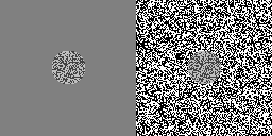
The Chubb illusion is an optical illusion or error in visual perception in which the apparent contrast of an object varies substantially to most viewers depending on its relative contrast to the field on which it is displayed.[1] These visual illusions are of particular interest to researchers because they may provide valuable insights in regard to the workings of human visual systems.
An object of low-contrast visual texture surrounded by a field of uniform visual texture appears to have higher contrast than when presented on a field of high-contrast texture. This illusion was observed by Charles Chubb and colleagues and published in 1989.[2] An empirical explanation of the Chubb illusion was published by Lotto and Purves in 2001.[1]
- ^ a b Lotto, R. Beau; Purves, Dale (July 2001). "An Empirical Explanation of the Chubb Illusion" (PDF). Journal of Cognitive Neuroscience. 13 (5): 547–55. CiteSeerX 10.1.1.488.377. doi:10.1162/089892901750363154. PMID 11506656. S2CID 30337884. Archived from the original (PDF) on 2006-09-07. Retrieved 2013-03-27.
- ^ Chubb, C; Sperling, G; Solomon, JA (December 1989). "Texture interactions determine perceived contrast". Proceedings of the National Academy of Sciences USA. 86 (23): 9631–5. Bibcode:1989PNAS...86.9631C. doi:10.1073/pnas.86.23.9631. PMC 298552. PMID 2594791.